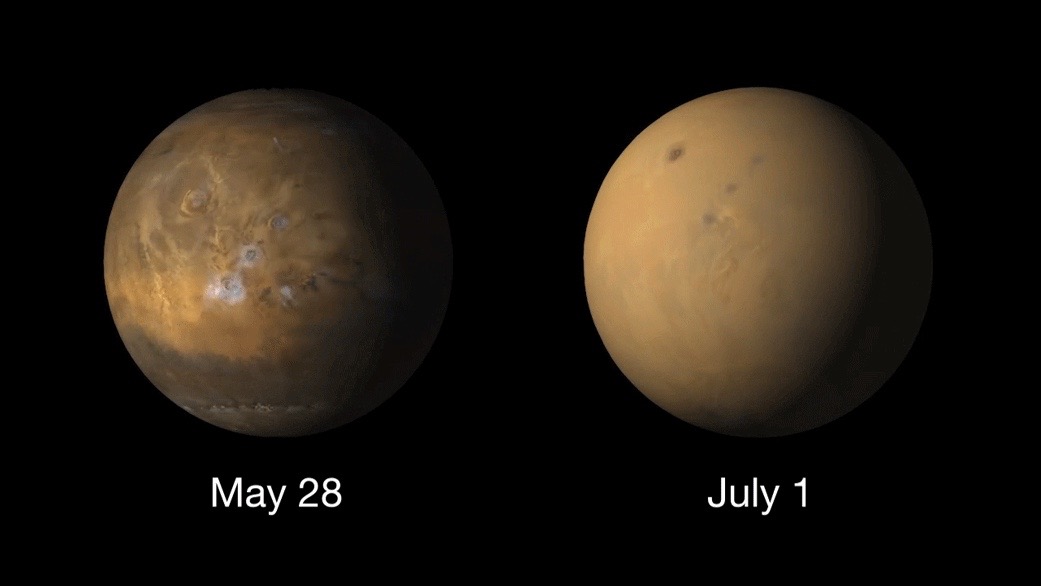
NASA's Curiosity Mars rover noticed this summer's monster dust storm fairly early on — but not in the way you might expect.
The storm was first spotted from above by NASA's Mars Reconnaissance Orbiter on May 30 as a localized event near Perseverance Valley, a landform being explored by the agency's Opportunity rover.
The dust storm grew quickly over the following days, as Curiosity's observations showed. Curiosity's home is the 96-mile-wide (154 kilometers) Gale Crater, on the other side of the planet from Perseverance Valley, but it saw signs of the storm on June 5. [Mars Dust Storm 2018: What It Means for Opportunity Rover]
Those signs were temperature readings, made by sensors on a motor on the car-size rover's deck, mission team members said. That motor powers the lid on a funnel that directs powdered rock samples from Curiosity's drill into its onboard chemistry-lab instrument, which is known as Sample Analysis at Mars (SAM).
"All my charts showed the dust storm effect on the actuator because it's exposed; it's sitting out there on the rover deck," Benito Prats, an electromechanical engineer at NASA's Goddard Space Flight Center in Greenbelt, Maryland, said in a statement. "All of a sudden, I saw the daytime temperature drop really quickly."

The nighttime temperature stayed abnormally high as well, as it does during big Martian dust storms: While all that dirt in the air blocks sunlight during the day, it also prevents infrared radiation from escaping to space at night, keeping things warmer than usual after the sun goes down.
The storm continued to grow, eventually encircling the planet by June 20. Its intensity plunged Perseverance Valley into perpetual darkness, blocking so much sunlight that the solar-powered Opportunity couldn't recharge its batteries. The golf-cart-size rover, which has been exploring Mars since January 2004, hasn't made a peep since June 10.
Get the Space.com Newsletter
Breaking space news, the latest updates on rocket launches, skywatching events and more!
The motor's temperature measurements helped the Curiosity team keep tabs on the storm (which they also did using the rover's onboard weather station). And Prats combined the dust-storm data with historic readings from the motor, to predict when the storm might start clearing up.
"At sol 2,125 (July 28), I noticed a linear trend," Prats said, "so I said, OK, I can predict that sol 2,180 (Sept. 23) is going to be when we're going to get out of the dust storm and the temperature will return back to normal, though I later updated that to sol 2,175 (Sept. 18)."
(A sol is a Martian day, which is about 40 minutes longer than an Earth day. The sol numbers referenced by Prats are the number of Martian days since Curiosity's touchdown on the Red Planet, which occurred on Aug. 5, 2012.)
That forecast proved accurate: Dust levels in Gale Crater had returned to normal by Sept. 18, according to the motor measurements, NASA officials said.
Curiosity was largely unaffected by the storm, because it runs on nuclear rather than solar power. (Curiosity is currently sidelined by an issue with its memory, however.)
The skies over Perseverance Valley have cleared as well. Indeed, Opportunity's handlers began stepping up their attempts to hail the silent rover on Sept. 11, kicking off a 45-day "active listening" campaign. If this effort fails to rouse the rover, the team will assess its next steps, NASA officials have said. Opportunity mission leaders have said that they'll keep listening on a passive basis at least through the end of January, however.
Scientists are eager to study all the data they can about the recent Mars dust storm, to get a better handle on these fairly regular, but poorly understood, events. For example, researchers can't accurately predict when a global dust storm will arise on Mars, and they don't know why some small storms balloon into planet-girding monsters, whereas others fade away.
"I can estimate, two years in advance, the temperature, air pressure, and whether there's going to be dust or clouds in the air during the non-dusty season anywhere on the planet," Scott Guzewich, an atmospheric scientist at NASA Goddard who leads Curiosity's dust-storm investigation, said in the same statement. "But during the dusty season, in locations that have dust storms, I can't give you any prediction at all that there will be a dust storm on one day and not another."
Follow Mike Wall on Twitter @michaeldwall and Google+. Follow us @Spacedotcom, Facebook or Google+. Originally published on Space.com.
Join our Space Forums to keep talking space on the latest missions, night sky and more! And if you have a news tip, correction or comment, let us know at: community@space.com.

Michael Wall is a Senior Space Writer with Space.com and joined the team in 2010. He primarily covers exoplanets, spaceflight and military space, but has been known to dabble in the space art beat. His book about the search for alien life, "Out There," was published on Nov. 13, 2018. Before becoming a science writer, Michael worked as a herpetologist and wildlife biologist. He has a Ph.D. in evolutionary biology from the University of Sydney, Australia, a bachelor's degree from the University of Arizona, and a graduate certificate in science writing from the University of California, Santa Cruz. To find out what his latest project is, you can follow Michael on Twitter.









